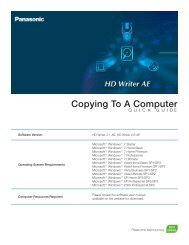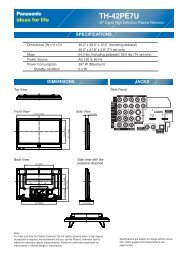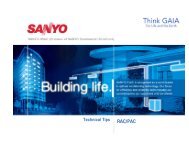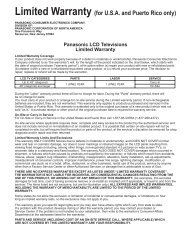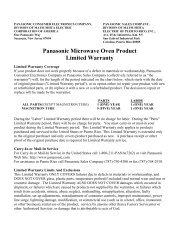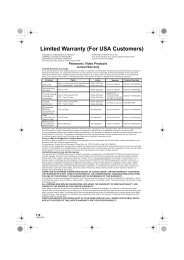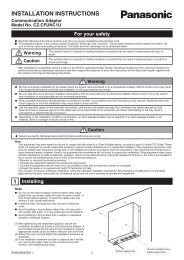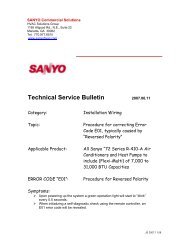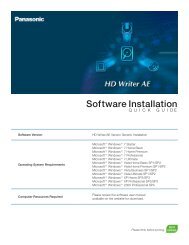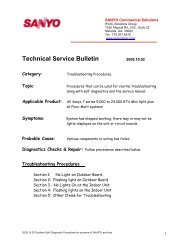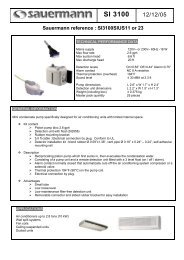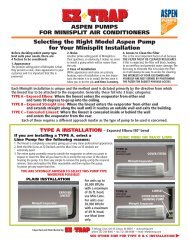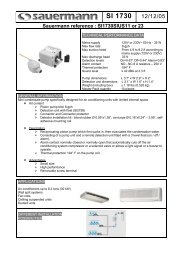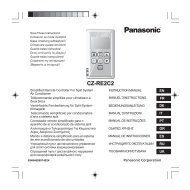technical & service manual dc inverter multi-system air ... - Panasonic
technical & service manual dc inverter multi-system air ... - Panasonic
technical & service manual dc inverter multi-system air ... - Panasonic
Create successful ePaper yourself
Turn your PDF publications into a flip-book with our unique Google optimized e-Paper software.
(11) Replace the flare nut on the wide tube <strong>service</strong> port and fasten the flare nut securely with an adjustable wrench or<br />
box wrench. Next, mount the valve cap and tighten it with a torque wrench (the cap needs to be tightened with the<br />
torque of 180 lbs·in (200 kgf·cm)). This process is very important to prevent gas from leaking from the <strong>system</strong>.<br />
(12) Test run the <strong>air</strong> conditioner. (See page 26.)<br />
(13) While the <strong>air</strong> conditioner is running, apply liquid soap to check for any gas leaks around the <strong>service</strong> valves or caps.<br />
(14) If there is no leakage, stop the <strong>air</strong> conditioner.<br />
(15) Wipe off the soap on the tubing.<br />
This completes <strong>air</strong> purging with a vacuum pump and the <strong>air</strong> conditioner is ready for actual operation.<br />
Pump Down<br />
In order to protect the earth’s environment, be sure to perform pump-down to recover refrigerant<br />
gas without releasing it into the atmosphere.<br />
When relocating or disposing of the <strong>air</strong> conditioner, request this<br />
<strong>service</strong> from the dealer where the unit was purchased, or from an<br />
appropriate agent. Perform pump-down as described below.<br />
What is pump-down?<br />
Pump-down refers to recovering the refrigerant gas from the refrigerant<br />
cycle at the outdoor unit. This work must be performed during<br />
cooling operation. The refrigerant gas cannot be recovered<br />
during heating operation.<br />
During winter, or if the temperature sensor prevents cooling operation,<br />
perform “forced cooling operation.”<br />
Pump-down procedure<br />
(1) Fully close the spindles at the valves on the narrow tube side of<br />
tubes A, B, C and D. (Refer to Fig. 22.)<br />
(2) Connect the manifold gauge to the charging port at the valve on<br />
the wide tube side of tube D. Purge the <strong>air</strong> from the charging hose.<br />
(Refer to Fig. 23.)<br />
(3) Perform cooling operation or forced cooling operation.<br />
When the pressure at the low-pressure side is 0.05 – 0.1 MPaG<br />
(0.5 – 1 kg/cm 2 G), fully close the spindles at the valves on the<br />
wide tube side of tubes A, B, C, and D, and immediately stop<br />
operation. (Refer to Fig. 23.)<br />
In the winter, the outdoor unit may stop after 5 - 10 minutes of<br />
operation. This is in order to protect the indoor unit heat<br />
exchanger from freezing and does not indicate a problem.<br />
(4) Disconnect the manifold gauge and the inter-unit tubes, and<br />
attach the caps and flare nuts. At this point, pump-down is completed.<br />
(If the caps and flare nuts are not reattached, there is the<br />
danger of gas leakage.) (Refer to Fig. 24.)<br />
If pump-down is not possible<br />
If the <strong>air</strong> conditioner cannot be operated because of a malfunction or<br />
other cause, use a refrigerant recovery device to recover the refrigerant.<br />
21<br />
Cap<br />
Cap<br />
Cap<br />
Cap<br />
Narrow tube side<br />
Charging port<br />
Wide tube side<br />
Charging hose<br />
Fig. 22<br />
Fig. 23<br />
Fig. 24<br />
Close<br />
Close<br />
Close<br />
Close<br />
D<br />
C<br />
B<br />
A<br />
Manifold gauge<br />
D<br />
C<br />
B<br />
A<br />
After disconnecting<br />
the inter-unit tubes,<br />
attach the flare nuts<br />
with flare bonnets.



